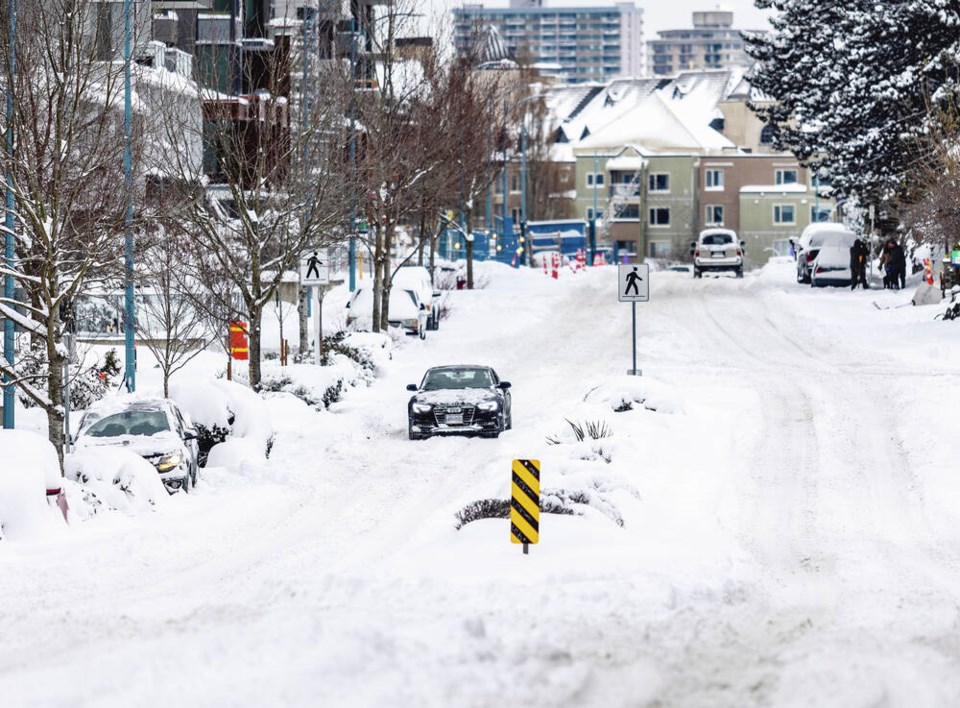During our last blast of winter I noticed more than a few stranded vehicles out there. Some were just plain stuck — too much snow happening too fast. That’s understandable.
But there were a few vehicles, including those uber-tough giant pickup trucks, which just seemed to have stalled out. Why?
It seems that the south Island version of stranded doesn’t mean being trapped in some barren wilderness; apparently it happens on your own street if your vehicle hasn’t had its winter makeover.
Avoiding routine maintenance can lead to non-routine problems when a real winter drops in on us.
Here are some of the things you should do to prep your vehicle for the winter — even around here.
Buy snow tires. They are expensive for sure. Generally, though, they will be cheaper than an ICBC claim, and way less stressful. They are a necessity even when there’s just a few inches on the ground.
All-season tires are not snow tires. There are now “all weather” tires that are acceptable and legal in winter, but the basic deal is that the tire must display an “M+S” symbol and/or a mountain or snowflake emblem.
Change your fluids. Summer fluids, such as engine coolant and windshield washer fluid, can fail in winter. Coolant failure can ruin your engine. Your mechanic can easily check fluid viability for winter temperatures. Remember we had a couple of minus-10 C days here last time out.
Washer fluid, and lots of it, is vital for clearing road spray when things start to melt a little.
Use winter wiper blades. They are extra durable and designed to clog up less with ice and snow. It’s always nice to see where you’re going, snowstorm or not.
Check your battery. At 0 C your car battery can lose 35% of its power — right at the times it’s harder to turn your engine over. Your mechanic can easily examine your battery during a maintenance check and “load test” it to see if it’s ready for winter. This includes ensuring the cable connections are clean and secure.
Keep a cell phone charger. Cell phones are lifelines in emergencies. Keeping them charged with a plug-in charger is a necessity during bad weather. Chargers are dirt cheap, so there’s no excuse.
Carry an emergency kit. This should include basic tools, a good flashlight, battery cables and gloves. Gloves are important. Easy tasks like turning or twisting bolts or tools can become agonizing in cold wet weather. You will need your fingers and hands, so protect them.
Glove Box
Danielle asked this week about the value of “run-flat” tires — tires that can keep on going despite being punctured.
There are two basic types. One incorporates an extra-strong sidewall that keeps supporting the tire when the air escapes, and one is called the inner-ring type which, as its name suggests, has a kind of “tire within a tire” made of hard rubber or other material which supports your vehicle when the regular outer tire has a leak.
Both systems are designed as temporary fixes to get you another 80 kilometres down the road to a repair shop.
Dan Korolyk, recently retired after 40-plus years in the auto service industry as a mechanic, commercial vehicle inspector and shop manager, says they probably aren’t worth the extra money.
Run-flats can range from 35% to 200% more than regular tires. “I think it’s a bit of a gimmick, expensive and not all repair shops can handle them.”
Korolyk sees them as a cost saver for carmakers. “A lot of manufacturers use them to avoid having to provide a spare and tools, means more trunk space, less worrying about where to mount jacks and tire tools.”
“Modern tires are pretty reliable these days, and it’s easy to carry an inflation canister in case of an emergency,” he said.
Aerosol flat fixers run $15 to $30 at any automotive store.
Another critical piece for run-flats is having a working tire pressure monitor system in your vehicle. You need to know immediately if you’ve lost tire pressure.
A J.D. Powers study in 2013 showed that run-flat tires generally offer about 9,000 kms less wear than regular tires. Combined with that greater cost, they’re a tough sell to me.
If you’re regularly driving long highway trips or through remote areas, though, they may appeal to you. The peace of mind to be able to get another 80 desolate kilometres may be worth it.
But if you’re a regular urban commuter, with easier access to roadside assistance or even family members, standard tires are quite adequate.




